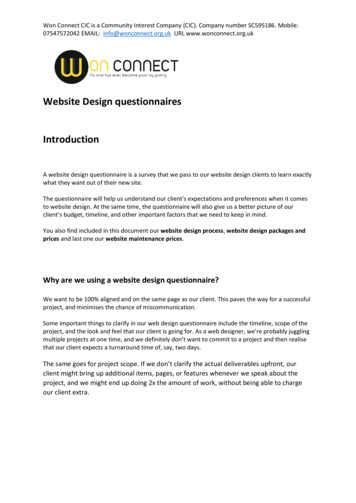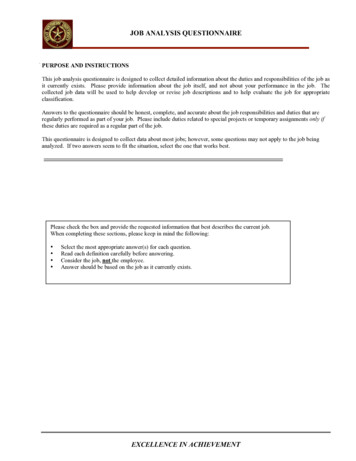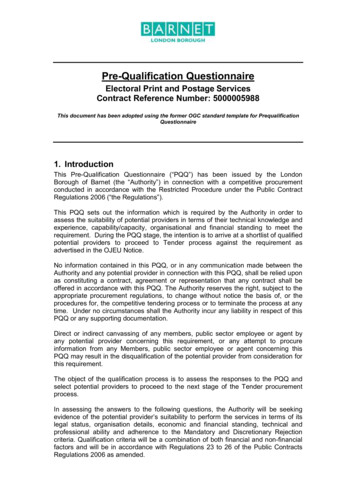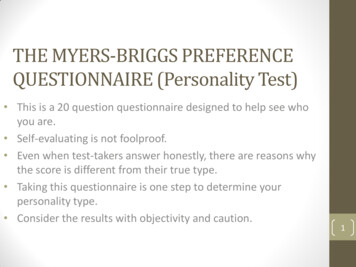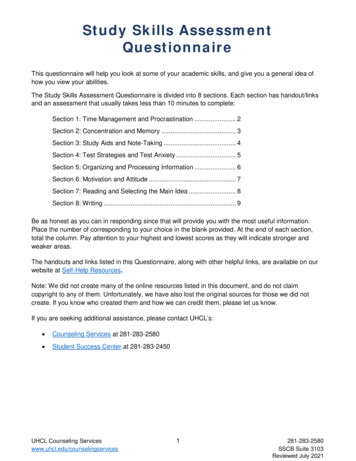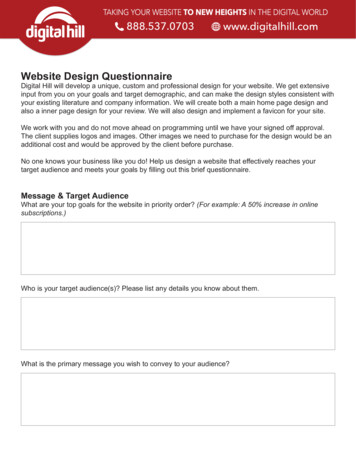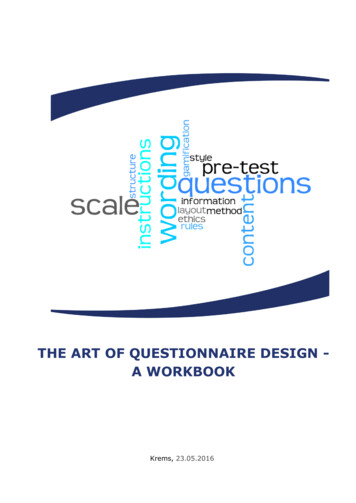
Transcription
THE ART OF QUESTIONNAIRE DESIGN A WORKBOOKKrems, 23.05.2016
Author:Mag. Stephanie TischlerIMC Fachhochschule Krems GmbHIMC University of Applied Sciences KremsA-3500 Krems, Piaristengasse 1T: 43 (0)2732 802 180E: stephanie.tischler@fh-krems.ac.atI: www.fh-krems.ac.at, www.tourismfactory.at2
Table of Contents1. Questionnaire design . 42. Questionnaire design process . 52.1.Information need . 52.2.Type of interviewing method. 82.3.Content of questions. 82.3.1.Necessity of questions . 82.3.2.Double-barreled questions . 92.4.Overcoming the respondent’s inability and unwillingness to answer . 92.4.1.Overcoming inability to answer . 92.4.2.Overcoming unwillingness to answer . 102.4.3.Gamification approaches . 112.5.Question structure. 142.6.Question wording . 182.7.Arranging the questions . 222.8.Form and layout . 252.9.Reproduction of questionnaires . 252.10.Pre-testing . 253. Ethics in questionnaire design. 26List of References . 27Annex – Questionnaire Design Checklist . 283
1. Questionnaire designA questionnaire is a formalized set of questions for obtaining information fromrespondents. It must translate the information needed into a set of specific questionsthat the respondents can and will answer. A questionnaire must uplift, motivate,and encourage the respondent to become involved in the interview, to cooperate,and to complete the interview. In order to minimize response error, a questionnaireshould contain all necessary instructions (for the respondent, for the intervieweretc.) (Malhotra, 2010, p. 335).Example:Which of these best describes the main purpose of your trip today? Chooseone purpose only!INTERVIEWER: Read out all answer categories, ask to specify others and write downall mentions. Going for a walkSitting and relaxing, enjoying the viewJust passing throughVisiting tourist/historic attractionsOther:12345In designing a questionnaire, the researcher should have sought out as muchprevious research on the topic or related topics as possible. Especially, if it isdecided that the study at hand should have points of comparison with other studies,data need to be collected on a similar basis. Questionnaires from previousstudies are always an important part of the input into the questionnaire designprocess (Veal, 2006, p. 249).4
2. Questionnaire design processThe questionnaire design process consists of several steps, which will be discussedin the following subchapters:Figure 1: The questionnaire design processSource: Malhotra, 2010, p. 3362.1.Information needIn a first step you need to specify the information needed. Review thecomponents of your research problem and the research questions and yourhypotheses. Furthermore, it is important to have a clear idea of the targetpopulation. The characteristics of the respondent group have a great influence onquestionnaire design and wording (Malhotra, 2010, p. 336).Very often researchers move too quickly into questionnaire design mode and beginlisting all the things that could be interesting to ask. It is not advisable to begin withthis list of questions to be included in the questionnaire. The starting point mustalways be an examination of the objectives and research questions (Veal, 2006, p.249).5
This step requires a lot of effort since you need to specify exactly what informationis to be collected from each respondent. Poor judgment and lack of thought at thisstage may mean that the results are not relevant to the research purpose or thatthey are incomplete. Both problems are expensive, and may seriously diminish thevalue of the study. Therefore, you need to translate research objectives intoinformation requirements and finally into questions (see Figure 2) (Aaker,Kumar, Day, & Leone, 2011, p. 276-7).Figure 2: Information needSource: Kumar, 2014, p. 190When constructing a questionnaire, you need to be cognizant of your aims andhypotheses, then you can to consider the variables you are attempting to study andfinally start to develop your questionnaire questions (Jennings, 2010, p. 247).6
Exercise:To specify the information needed try to answer the following questions:7
2.2.Type of interviewing methodThe interviewing method may influence your questionnaire design as thequestionnaire may have to be administered differently for each method. In personalinterviews respondents see the questionnaire and interact face to face withinterviewer. This allows more complex, lengthy and varied questions. In telephoneinterviews respondents do not see the questionnaire, which means that questionsshould be very short and simple. Mail and internet questionnaire are selfadministered. Therefore, questions must be simple and detailed instructions must beprovided (Malhotra, 2010, p. 337).Exercise:To learn more about the specifications of your interviewing method, try toanswer the following questions:What kind of interviewing method will you apply?What should you consider when using this type of interviewing method?2.3.Content of questionsThe next question you have to deal with is: What to include in individual questions?2.3.1.Necessity of questionsEvery question should contribute to the information needed or serve somespecific purpose. If there is no satisfactory use for the data resulting from aquestion, this question should be eliminated. In certain situations, questions may beasked that are not directly related to the information that is needed (e.g. neutralquestions at the beginning of the questionnaire when the topic of the questionnaireis sensitive, filler questions to disguise the purpose of the project) (Malhotra, 2010,p. 338).8
2.3.2.Double-barreled questionsSometimes, several questions are needed to obtain the required information in anunambiguous manner. Avoid double-barreled questions, where two or morequestions are combined into one. To obtain the required informationunambiguously, two distinct questions have to be asked (Malhotra, 2010, p. 339).Example:Do you think Coca-Cola is a tasty and refreshing soft drink?2.4.Overcoming the respondent’s inability andunwillingness to answerA researcher should not assume that respondents can provide accurate or reasonableanswers to all questions. Certain factors may limit the respondents’ ability to providethe desired information (Malhotra, 2010, p. 339).2.4.1.Overcoming inability to answer Make sure that the respondents only have to answer questions on whichthey are informed. Research has shown that respondents will often answerquestions even though they are uninformed! In such situations, filterquestions have to be included to enable the researcher to filter outrespondents who are not adequately informed. Furthermore, a “don’t know”option should be provide when the researcher expects that respondents maynot be adequately informed about the subject of the question (Malhotra, 2010,p. 340). Questions may exceed the ability of the respondents to remember. Theinability to remember leads to errors of omission (inability to recall an eventthat actually took place), telescoping (when an individual telescopes orcompresses time by remembering an event as occurring more recently than itactually occurred) or creation (when a respondent “remembers” an event thatdid not actually occur) (Malhotra, 2010, p. 340f).Example:How many gallons of soft drinks did you consume duringthe last four weeks?9
Respondents may be unable to articulate certain types of responses.Then they are likely to ignore the question and may refuse to respond tothe rest of the questionnaire. Thus respondents should be given aids, such aspictures, maps and descriptions to help them articulate their responses(Malhotra, 2010, p. 341).Example:Please describe the atmosphere in this store!2.4.2.Overcoming unwillingness to answerEven if respondents are able to answer a question, they might be unwilling to do so. Most respondents are unwilling to devote a lot of effort to provide information.Hence, the researcher should minimize the effort required of therespondents (Malhotra, 2010, p. 341).Example:Please list all the departments from which you purchased merchandise onyour most recent shopping trip to a department store. Some questions may seem appropriate in certain contexts, but not in others.Respondents are also unwilling to give information that they do not see asserving a legitimate purpose. The researcher should therefore provide contextinformation and legitimate the purpose (Malhotra, 2010, p. 342). Respondents are unwilling to disclose sensitive information because thismay cause embarrassment or threaten the respondent’s prestige or selfimage. Sensitive topics include money, family life, political or religious beliefs,and involvement in accidents or crimes. The approaches described in the nextsection can help to increase the likelihood of obtaining information thatrespondents are unwilling to give (ibid.). The willingness of respondents to provide information can be increased bythe following techniques (Malhotra, 2010, p. 342f):o Place sensitive topics at the end of the questionnaire, as initial mistrusthas been overcome by then.o Use the third-person technique. Phrase the question as if it referred toother people.o Hide the question in a group of other questions that respondents arewilling to answer.o Provide response categories rather than asking for specific figures.10
2.4.3.Gamification approachesGamification approaches can especially help to overcome unwillingness toparticipate in a survey. Gamification tries to design more effective research asrespondents are less and less willing to participate in a survey. Furthermore, it seeksto increase survey experience and makes survey completion more fun andentertaining. Gamification can therefore act as motivator and enhance responserates, as respondents spend longer time on answering the questions and quality ofdata produced is increased (Puleston, 2014). Rethink question wording: Avoid overblown phrasing of questions,especially if you can offer visual cues (Puleston, 2014, p. 261f).Example:On a scale of 1 to 10, how much do you agree or disagree with thesestatements where 1 means you completely disagree and 10 means youcompletely agree and 5 means you neither agree nor disagree. Change question style: Use a more engaging approach throughpersonalization, emotionalization and projection (Puleston, 2014, p. 263f).Examples:PersonalizationWhich of these paint colours do you like best?Better: If you had to paint your room in one of these colours, which one would youpick?EmotionalizationWhich clothing style do you prefer?Better: What would you wear on a first date?ProjectionWhat do you think about this new product?Better: Image you are the boss of a company. Your job is now to evaluate the newproduct. Apply rules to question design: Rules can turn questions into mental puzzles,that are more interesting and challenging to answer (Puleston, 2014, p. 265).11
Example:Please describe yourself!Better: Please describe yourself using ONLY 7 words! Turn questions into quest: Re-word questions to seem more like quests andmissions (Puleston, 2014, p. 267).Example:How much do you like these musical artists?Better: Image you owned your own radio station and could play any music youliked. Which of these artists would you place on your play list? Use scenarios: Change a question to evoke a process like scenario planning,using “what if“ questions and imaginary situations (Puleston, 2014, p. 269).Example:What words would you use to describe this brand?Better: Imagine this brand was a human being; what words would you use todescribe this person? Add a competitive element: Add any form of competition to a survey suchas challenges and time limits or ask people to guess what other people think.Examples:Please write down all insurance companies you can recall.Better: We challenge you to write down the names of as many insurancecompanies as possible within the next 2 minutes.Please write down the words you associate with brand X?Better: What are the top five words people associate with brand X? What do guess?12
Exercise:What kind of gamification approaches could you use to overcomeunwillingness to participate in a survey and unwillingness to answer yourquestions? Try to develop 2 different approaches for your questionnaire.13
2.5.Question structureA question may be unstructured or structured (see Figure 3). Both types havetheir advantages and disadvantages.Figure 3: Question structureSource: Malhotra, 2010, p. 343-5Unstructured questions are open-ended questions that respondents answer intheir own words. These free-response or free-answer questions are good as firstquestions on a topic. They enable the respondents to express general attitudes.Unstructured questions have much less biasing influence on responses. However, thepotential for interviewer bias is very high and coding of responses is costly and timeconsuming (Malhotra, 2010, p. 343).Example:What are the main reasons for your visit to this destination?14
Structured questions specify the set of response alternatives and theresponse format. A structured question may be multiple choice, dichotomous or ascale (Malhotra, 2010, p. 344).Multiple choice questions provide a choice of answers and respondents areasked to select one or more of the alternatives given.Example:What are the main reasons for your visit to this destination? RecreationBusinessSightseeing Dichotomous questionsagree/disagree, :Is this your first visit to this destination? Yes NoScale questions offer the respondent a scale for his/her answer. Scaling involvesthe creation of a continuum upon which measured objects are located. The scalingtechniques commonly employed in marketing research can classified intocomparative and noncomparative scales. Comparative scales involve the directcomparison of objects (e.g. brand A vs. brand B). In noncomparative scales eachobject is scaled independently of the others in the stimulus set. Comparative scalesare for example paired comparison scales, rank order scales and constant sum scales.Examples of noncomparative scales are continuous rating scales and itemized ratingscales such as Likert or semantic differential scales (Malhotra, 2010, p. 282ff).Example:Please think of United Airlines and its characteristics. Please tick the boxthat best indicates how accurately one or the other adjective describes yourpicture of United Airlines.PleasantUnreliable Modern 15UnpleasantReliableOldfashioned
In general, the number of points along the scale should be limited. Commonpractice is five or fewer points for unipolar scales (scales that measure alongone dimension such as from “poor” to “excellent”) and seven or fewer points alonga bipolar scale (scales that measure in two directions, for example from “verydissatisfied” to “very satisfied”) (Taylor-Powell, 2008).Regarding odd or even point scales, there is no preferred or better choice. An oddnumber of points allows people to select a middle option. An even number forcesrespondents to take sides. An even number is appropriate when you want to knowwhat direction the people in the middle are leaning. However, forcing people tochoose a side, without a middle point, may frustrate some respondents (TaylorPowell, 2008).Usually it is helpful for the respondent to provide graphical aids and configuration(see Figure 4).Figure 4: Rating scale configurationsSource: Berekoven, 2009, p. 69Providing a word label over each point better ensures that everyone interprets thepoints similarly reducing measurement error. Also, few people express their opinionsin numerical terms so numbers have less meaning to respondents. Numbers mayconfuse respondents or have unintended meaning so numbers can be removed fromthe scale (Taylor-Powell, 2008). Commonly used scale descriptors can be found inFigure 5.16
Figure 5: Examples of scales descriptorsExercise:What kind of scales do you need for your questionnaire? Develop yourscales and their descriptors.17
2.6.Question wordingQuestion wording is the translation of the desired question content and structure intowords that respondents can clearly and easily understand (Malhotra, 2010, p.346). To avoid problems, the following guidelines should be followed: A question should clearly define the issue being addressed. Define the issueand be specific: who, what, when, where and why? (Malhotra, 2010, p. 346).Example:Which countries do like as holiday destinations? Don’t use technical terms, always try to use ordinary words (Malhotra,2010, p. 347).Example:Do you think the distribution channels of soft drinks are adequate? Use unambiguous words which don’t have different meanings to differentpeople (ibid.).Example:How often do you play football? Never Occasionally Sometimes Often Regularly Avoid leading or biasing questions (as respondents have the tendency toagree - „Yea-Saying“) (Malhotra, 2010, p. 348).Example:Do you think that patriotic Americans should buy imported automobileswhen that would put American labor out of work?18
Avoid implicit alternatives or implicit assumptions (ibid.).Example:Are you in favor of a balanced budget? Avoid generalizations and estimates (Malhotra, 2010, p. 349).Example:What is the annual per capita expenditure on groceries in your household? Word statements both positively and negatively (ibid.).Example:1United Airlines has a poor in-flight service.United Airlines charges fair prices.I like to fly with United Airlines.19234Stronglyagree 5Stronglydisagree
Exercise:Try to state improved versions of the following questions:Bad exampleImproved versionWhat is your frequency of utilisationof public means of transport?Do you go to the cinema or theatrevery often?Are you against the extension of theairport?Do you use the local arts centre, andif so what do you think of itsfacilities?Which shampoo do have at home?How often do you visit a leisurepark?- Often- Sometimes- Rarely- Never20
Exercise:Develop three questions for your questionnaire following all rules forquestion wording. Don’t forget to reconsider your information need.21
2.7.Arranging the questionsAfter proper questions wording, it is necessary to determine the order of questions. Opening questions: The opening questions are crucial in gaining theconfidence and cooperation of respondents. Opening questions should beinteresting, simple, and nonthreatening. In some cases, it is necessary toscreen the respondents or determine whether the respondent is eligible to takepart in the survey. Here, the qualifying questions serve as the openingquestions (Malhotra, 2010, p. 349ff). Type of information: Basic information (core questions to answer theresearch problem) should be obtained first, followed by classificationinformation (socioeconomic and demographic characteristics) and, finally,identification information (name, address, telephone number, etc.) (ibid.). Difficult questions: Difficult questions or questions that are sensitive,embarrassing, complex, or dull should be placed late in the sequence (ibid.). Effect on subsequent questions: Sequencing questions is a critical tasksince in can lead to order bias, where responses to earlier questions influencethe later ones (Mayo, 2014, p. 182). As a rule of thumb, general questionsshould precede specific ones (funnel approach) (Malhotra, 2010, p. 350f). Logical order: All questions dealing with a particular topic should be askedbefore beginning a new topic. When switching topics, brief transitional phrasesshould be provided. Branching questions shall be used to guide through asurvey by directing to different spots on the questionnaire depending on theanswers given. As skip patterns can be quite complex, a flowchart of all logicalpossibilities to go through a questionnaire should be created (ibid.).A useful tool for planning questionnaires is the diagram. Some researchers fellcomfortable using flowcharts (see Figure 6) as a planning tool, where a diagramshows the key pathway for the respondent answers (Bradley, 2013, p. 207).22
Figure 6: Example of flowchart for questionnaire designEach questionnaire (part) needs a set of instructions regardless of whether it isself-completion or interviewer administered, especially when questions areinappropriate (due to filtering or different paths through a questionnaire).Respondents or interviewers need to be told to “skip and go to” the next relevantquestion. The absence of an interviewer causes particular problems for selfcompletion questionnaires. Consequently the questionnaire must not only capturethe interest of the respondent but should also contain clear instructions on how tocomplete it (Finn, Elliott-White, & Walton, 2000, p. 101).23
Exercise:Develop a flowchart for your questionnaire:24
2.8.Form and layoutThe format, spacing and positioning of questions can have a significant effect on theresults. It is good practice to divide a questionnaire into several parts. Thequestions in each part should be numbered, particularly when branching questionsare used. The questionnaires should preferably be precoded. The questionnairesthemselves should be numbered serially. This facilitates the control ofquestionnaires (e.g. to control if questionnaires have been lost) (Malhotra, 2010, p.352).2.9.Reproduction of questionnairesHow a questionnaire is reproduced can influence the results. For example, if thequestionnaire is reproduced on poor-quality paper or is shabby in appearance, therespondents will think the project is unimportant and the quality of response will beadversely affected. The questionnaire should therefore have a professionalappearance. Questionnaires should take the form of a booklet rather than anumber of sheets. Grids are useful when there are a number of related questionsthat use the same set of response categories. The tendency to crowd questionstogether to make the questionnaire look shorter should be avoided. Directions orinstructions for individual questions should be placed as close to the questions aspossible (Malhotra, 2010, p. 353).2.10. Pre-testingPretesting refers to the testing of the questionnaire on a small sample of respondentsto identify and eliminate potential problems. A questionnaire should not be usedin the field survey without adequate pretesting. All aspects of the questionnaireshould be tested, including question content, wording, sequence, form and layout,question difficulty and instructions (Malhotra, 2010, p. 354).The respondents for the pretest and for the actual survey should be drawn from thesame population. Pretests are best done by personal interviews, even if the actualsurvey is to be conducted by mail, telephone, or electronic means, becauseinterviewers can observe respondents' reactions and attitudes. After the necessarychanges have been made, another pretest could be conducted by mail, telephone, orelectronic means if those methods are to be used in the actual survey. A variety ofinterviewers should be used for pretests. The pretest sample size varies from 15 to30 respondents for each wave. Respondent shall be asked to “think aloud” whileanswering the questionnaire. Finally, the responses obtained from the pretest shouldbe coded and analyzed to check adequacy of data and data analysis (ibid.).25
3. Ethics in questionnaire designSeveral ethical issues may have to be addressed in questionnaire design. Of particularconcern are the use of overly long questionnaires, asking sensitive questions anddeliberately biasing the questionnaire (Malhotra, 2010, p. 359-60).Respondents are volunteering their time and should not be overburdened bysoliciting too much information. The researcher should avoid overly longquestionnaires. Usually questionnaires that take more than 30 minutes to completeare generally considered overly long and will adversely affect the quality ofresponses. Similarly, questions that are confusing, exceed the respondents’ ability,are difficult, or are otherwise improperly worded should be avoided (Malhotra, 2010,p. 359).Sensitive questions deserve special attention. The researcher should not invaderespondents’ privacy or cause stress. To minimize discomfort, it should be madeclear at the beginning of the interview that respondents are not obligated to answerany question that makes them uncomfortable (ibid.).Finally, the researcher has the ethical responsibility of designing the questionnaire soas to obtain the required information in an unbiased manner (e.g. stating leadingquestions or giving inappropriate or leading examples how to answer a question)(Malhotra, 2010, p. 360).26
List of ReferencesAaker, D. A., Kumar, V., Day, G. S., & Leone, R. P. (2011). Marketing Research(10th edition). Hoboken: Wiley.Bradley, N. (2013). Marketing Research - Tools & Techniques (3rd edition). Oxford:Oxford University Press.Finn, M., Elliott-White, M., & Walton, M. (2000). Tourism & Leisure ResearchMethods. Data Collection, Analysis and Interpretation. Harlow: PearsonEducation.Jennings, G. (2010). Tourism Research (2nd edition). Milton: Wiley.Malhotra, N. K. (2010). Marketing Research. An Applied Orientation (6th edition).New Jersey: Pearson.Mayo, F. B. (2014). Planning an applied research project in hospitality, tourism &sports. Hoboken: Wiley.Puleston, J. (2014). Gamification of market research. In C. A. Hill, E. Dean, & J.Murphy (Eds.), Social Media, Sociality, and Survey Research (pp. 253–293).Hoboken, NJ: Wiley.Veal, A. J. (2006). Research Methods for Leisure and Tourism. A Practical Guide(3rd edition). Harlow: Prentice Hall, Financial Times.27
Annex – Questionnaire Design Checklist28
Source: Malhotra, 2010, p. 355-629
THE ART OF QUESTIONNAIRE DESIGN - A WORKBOOK . 2 Author: Mag. Stephanie Tischler IMC Fachhochschule Krems GmbH IMC University of Applied Sciences Krems A-3500 Krems, Piaristengasse 1 T: 43 (0)2732 802 180 E: stephanie.tischler@fh-kr


